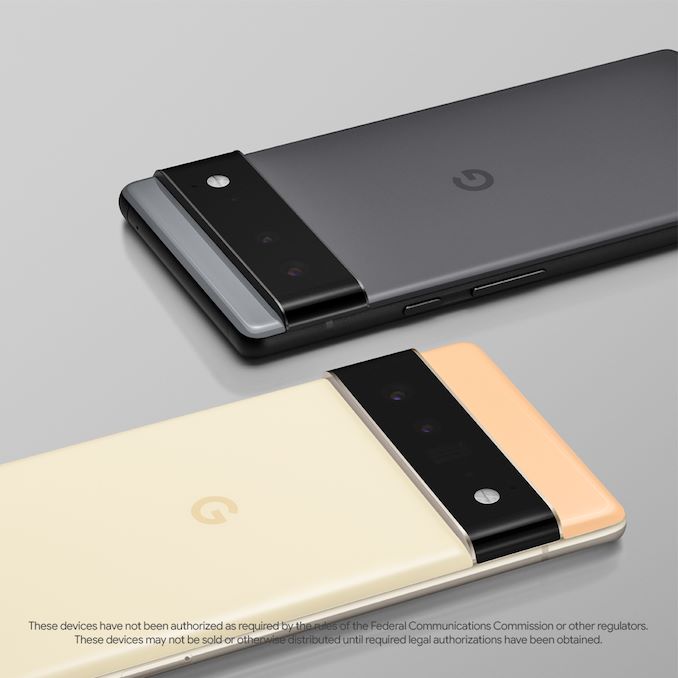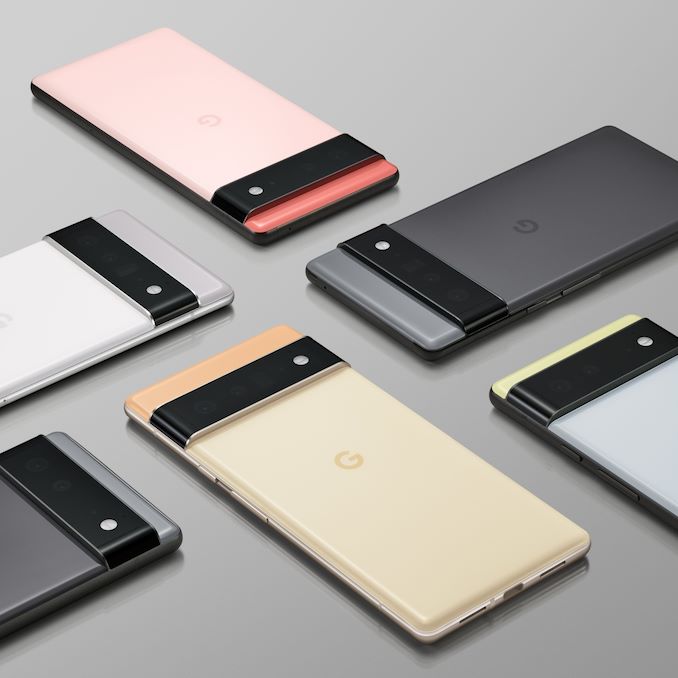Google Teases Pixel 6 and Pixel 6 Pro with new "Tensor" SoC
by Andrei Frumusanu on August 2, 2021 1:55 PM EST- Posted in
- Mobile
- Smartphones
- Pixel 6
- Pixel 6 Pro

Today Google has teased its new upcoming Pixel 6 and Pixel 6 Pro phones; in what is likely an attempt to get leaks and the upcoming narrative of the product under control, as opposed to the previous years of quite severe product spoilers several months ahead of the actual official product launches, the company is themselves revealing large important bits about the upcoming new flagship phones.
Google reveals that this year’s Pixel phones will be called the Pixel 6 and the Pixel 6 Pro, two seemingly similarly sized devices in a high-end configuration with some compromises, and one in an all-bells-and-whistles uncompromising device. In a more exclusive prebriefing with The Verge, it’s stated that the new devices will be truly flagship specced phones competing at the highest end of the market, marking an important step away from the mid-range of the last several years. This is a large shift for Google and has been one of our main criticisms over the last few years – a seeming lack of clear direction where Google wants to be with their Pixel phones, at least until now.
The first big news and confirmation from Google is the fact that the new Pixel 6 phones will be powered by a custom SoC that Google has dubbed the “Google Tensor”. For a few years now it had been rumoured that Google would be the first customer of Samsung LSI’s new semi-custom SoC business – essentially a design and manufacture for hire service that would allow OEMs to work very closely with SLSI in designing differentiated products. Essentially this would be the exact same business model AMD uses in partnership with the console vendors.
What’s interesting here is exactly what’s part Google, and what’s part Samsung LSI and stemming off from the Exynos SoC line-up. The one thing that had been assumed and has been confirmed today is that Google is employing their own AI/ML/NPU IP in the new chip, basically leveraging the company’s experience off their datacentre TPU hardware designs and IP, and integrating it into an SoC. In a sense, this also might be a successor to the Pixel Visual Core, with the large power efficiency and cost savings advantage that Google is now able to integrate it into the primary SoC.
In terms of other specifications of the SoC, there were no further details revealed at this time, but generally given the expected fall release date of the devices, it’s generally to be assumed that the chip would feature the same generation IP blocks in terms of CPU and GPU as other 2021 SoCs such as the Exynos 2100. This wouldn’t be a complete move away from past Pixel device’s release schedule not matching the industry’s IP release cadence – I would still expect the Q1 2022 SoCs to vastly out-spec it, but it’s at least a large improvement thanks to the new hardware differentiation.
The one large question that remains to see is how things play is in terms of the cellular capabilities – notably the device dropping Qualcomm as the preferred chipset vendor would also mean that this would be the only second other design besides Qualcomm featuring mmWave connectivity, which will be interesting to see. Samsung had noted back in 2019 that they had mmWave modules, and although we didn’t see them in 2020, maybe the new Pixel phones will be the first to feature them.
Material You will be best on #Pixel6.
— Made By Google (@madebygoogle) August 2, 2021
The colors, the camera, the form, and what’s on the screen all work together in a single, fluid experience.
(9/13) pic.twitter.com/K6BRF9ZKEY
In terms of the actual Pixel 6 phones, the Pixel 6 is advertised as having a 6.4” screen at a presumably lower FHD+ resolution, with flat glass design, while the Pixel 6 Pro is a 6.7” phone and a presumably QHD+ resolution. Both screens are reportedly 120Hz refresh rate as per the The Verge, though MKHD notes 90Hz on the regular unit.
The design of the new Pixels is defined by what Google describes as the “camera bar”, which is an interesting take on merging the needed camera bump and embracing it into the phone’s design. The large feature is very much unapologetic and horizontally covers the width of the phone, being rounded off to the sides. It somewhat reminds me of the Mi 11 Ultra bump, just much thinner and more subdued.
In terms of cameras, both phones feature an ultra-wide and a regular wide-angle, both with new sensors that are advertised to have much better light gathering capabilities. The Pixel 6 Pro also gets a periscope telephoto module with 4x optical magnification, meaning it’ll end up around 105mm equivalence. Google’s decision to go with a lower focal length here is I think extremely good as it avoids the large quality gap, and if the company employs a high-resolution sensor on the new module, it’ll still be able to have great spatial resolution at >8x magnification.
The camera software and processing are said to be extremely integrated with the new Tensor SoC and the ML IP block of the chip, enabling new features such as using HDRnet in video recording, running the same image pipelines that previously only were possible in still shots.
Google plans to formerly announced and launch the Pixel 6 and Pixel 6 Pro “this fall”.











46 Comments
View All Comments
flyingpants265 - Sunday, August 8, 2021 - link
It's absolutely astounding that multi-billion dollar companies cannot succeed in creating a good phone. Just make it fully-featured and lightweight, and actually improve Android instead of ruining it. Only then will I be willing to pay the $1000.mode_13h - Monday, August 9, 2021 - link
I think Google's motives are more complex than simply making a phone that lots of people want to buy. They're probably also trying to shift what their competitors are building, as well as building something of a technology platform for rolling out new Android features and capabilities.As I say all of that, I'm currently not planning on buying a Pixel phone. I won't say "never", but they seem overpriced and I question the value (for me) of some of their big features. I did have a Nexus phone and like the idea of a phone running stripped-down Android with 1st class support.
JoeDuarte - Tuesday, August 24, 2021 - link
Google and Pixel seem to be on autopilot, just coasting in lockstep with Apple and Samsung, maybe a bit behind.It would be neat if they built a new, sane OS. We're about 20 years overdue for **instant computing**. Given the advances in CPU, GPU, RAM, and solid states storage performance at this point, there's no excuse for computers to not be instant with respect to user actions (except for heavy processing tasks like video transcoding or similar). I mean that every mundane action should happen instantly, where "instantly" means some fraction of a second, like 200 ms, maybe 100 ms. Apps should open in 200 ms at most – I mean the fullest sense of open, fully loaded/displayed and ready to receive user input. Anything a user does in an app, typically via a mouse click or screen tap, should complete in 200 ms or less, like a menu opening, file opening, etc. Keyboard latency should be super minimal. On mobile it should be touchscreen latency bound, and that touchscreen latency should be worked and worked and worked to get it as low as possible.
(I read somewhere that Apple had robustly targeted some low touchscreen latency level for the iPhone, and achieved it. I think it was some multiple of 100 ms, maybe 200 or 400, but I don't remember. It was supposed to be lower than Android's touchscreen latency. This was at least five years ago, and I'm not sure what the situation is today. I also read that Apple had achieved something very close to instant computing in recent iPads. It sounded like they had finally crossed the threshold of brute-forced instant computing, by having a sufficiently powerful CPU/GPU and maybe working the latency issue a bit.)
Today's computers are ridiculously slow, miles away from instant computing. Someone should take a first principles approach, and think about what is minimally required to render an application window on a digital display in response to a user action like a tap or mouse click. Right now, it must take millions of GPU cycles, maybe billions, which is wildly unacceptable and terrible systems engineering. The amount of time it takes to open an Android app is far greater than the published latency figures for flash storage, SSDs, etc. I'm usually on a current flagship, like now the Galaxy S21 with the Snapdragon 888, which has one Cortex-X1, three Cortex-A78 cores, four A55 cores, 8 GB of LPDDR5, and a UFS 3.1 flash storage interface. And yet, hardly any app opens instantly, and the browsers are all unacceptably slow.
Same with desktop like Windows 10. It would be great if Google really innovated and came up with a sane OS. It could also be fundamentally secure in ways not possible with legacy OSes and programming languages. I don't know if Flutter has any goals re: instant computing, but we should have landed on it by 2000 or so. Another bland phone running a legacy slow OS is just not worth the effort.
JoeDuarte - Tuesday, August 24, 2021 - link
I meant millions of CPU cycles, not GPU.JoeDuarte - Tuesday, August 24, 2021 - link
I'm also stumped by why smartphones are so thick. Anyone notice that Apple didn't actually make the iPhone thinner after removing the headphone port? They said it was partly to save space, in addition to their "courage" and so forth, but they never actually delivered any such benefit to their users – no shrinkage.Smartphones have been getting slightly thicker recently, even though lots of these jerks have removed the headphone port. This is one area where I think thinner is better. Instead of obsessing over the thinness of their *desktop* computers (iMac), Apple should've made their mobile devices thinner.
For a smartphone, thinner and lighter is better. I'd really enjoy something at least a full millimeter thinner than the S21 and Pixel series. 6.5 mm would be a good target. Men don't have purses, so thickness and bulk hit us more since we have to put these beasts in our pockets. Smartphone are too large right now. It's ridiculous.
It's also crazy that they don't have headphone ports. That whole trend is just awful decision-making. There's no benefit to the user in removing that port, and it's damn near perfect for its purpose. Wired is always better than wireless, for both quality and battery. There's just no reason to replace such a simple and good solution with finicky and expensive and lower audio quality Bluetooth gadgets, wireless buds, etc. Especially those Apple ear thingies – they make people look exactly like Ben Stiller in "There's Something About Mary", when he opens the door to Cameron Diaz with something on his ear...